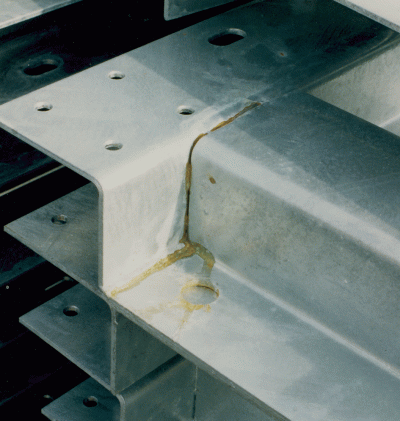The durability of hot dip galvanizing is one of its biggest advantages. By choosing galvanizing as corrosion protection, many years of maintinace free life time could be expected. To get the best result, there are some things to be aware of, which will be explained below:
Choose a steel that is suitable for galvanizing
Hot dip galvanizing is a chemical reaction between steel and zinc – that is why the steel composition is of large importance for the outcome. It is important to state that the steel should be suitable for hot dip galvanizing when the material is purchased. Suitable material has either a silicon + phosphorus content < 0.03 % by weight or a silicon content > 0.14 % by weight.
The layer thickness increases with increasing silicon content over 0.14 % by weight. Too high coating thickness is not desirable, since the layers may become brittle. Steel with higher silicon content than 0.35 % by weight is normally not used for galvanizing.
Suitable design
It is an advantage if large structures, especially in cases were welding will create mechanical stresses, instead are hot-dip galvanized as smaller segments which are joined by bolting after galvanizing. Tensions may relax in the hot zinc bath and cause distortion. Risk of deformations also applies to larger flat plates with material thicknesses less than 3-4 mm, which normally have to be stiffened. In Nordic Galvanizers ”Handbook in Galvanizing” there are pictures and descriptions of how structures suitable for hot dip galvanizing should be designed. See also “Design and fabrication of structures”. (https://nordicgalvanizers.com/c/)
Thermal cutted surfaces on the construction
Thermal cutting affects the steel in the cutted surface so that both the reactivity and the layer adhesion may change. Such surfaces should therefore be grinded or blasted prior to galvanizing to ensure a good result.
Avoid acid traps
It is important that through pores are not formed. If acid from the pretreatment has penetrated into a slit or pore, it cannot be removed later. Since molten zinc is more viscous than acid, it will seal the opening during galvanizing. After a while the acid causes holes in the coating over the opening. A rust-colored liquid then runs on to the surface and spoil the apparence.
Structures shall be designed so that narrow gaps, less than 3 mm, does not arise. Butt welds are much better than the overlap welds for constructions that will be galvanized. Narrow gaps can cause same types of problems that is described in paragraph 4 above.

Venting holes
Right located venting holes in the constructions provides safe galvanizing, internal corrosion protection and good drainage – discuss with your galvanizer for advice.
Suitable hole diameters for different dimensions of hollow sections are given below:
| Round profile (mm) | Scuare profile (mm) | Rectangular profile (mm) | Diameter, through hole (mm) |
| 20 | < 20 | 30×15 | 10 |
| 30 | < 30 | 40×20 | 12 |
| 40 | < 40 | 50×30 | 14 |
| 50 | < 50 | 60×40 | 16 |
| 60 | < 60 | 80×40 | 20 |
| 80 | < 80 | 100×60 | 20 |
| 100 | < 100 | 120×80 | 25 |
| 120 | < 120 | 160×80 | 30 |
| 160 | < 160 | 200×120 | 30 |
The steel surfaces must be clean
Paint, grease, weld slag and other foreign substances must not appear on items being galvanized! These contaminants will not disappear in the pre treatment but remains on the surface and disrupts the reactivity between steel and zinc.
Supplementary treatments or other special requirements
If painting or other post treatment of the galvanized steel will be performed, the galvanizer has to be informed about this prior to galvanizing. Galvanizing is primarily a corrosion protection method, but very nice design surfaces can also be created. However, it is important to inform the galvanizer when special demands on the surface finish exists. In cases where the product will be used in architectural contexts (on building facades, balcony railings, etc.) this should be taken into consideration already in the procurement of steel and the construction design, see paragraphs above. Furthermore, the galvanizer has to be informed about the requirements for surface finish, which may affect how the hot dip galvanizing is performed. In some cases it may be advantageous to make pre galvanizing of a few details before a larger amount of products are galvanized.
Packing and transportation of galvanized steel
Even though a hot-dip galvanized coating is capable of withstanding fairly rough treatment it should be handled with care during storage and transportation. In case of long goods simple packing and binding into bundles not only protects against mechanical damage but it often facilitates transportation itself. However, packing and binding should be done in such a way as to avoid risk of wet storage strain. Spacers should be used to prevent such attacks.
